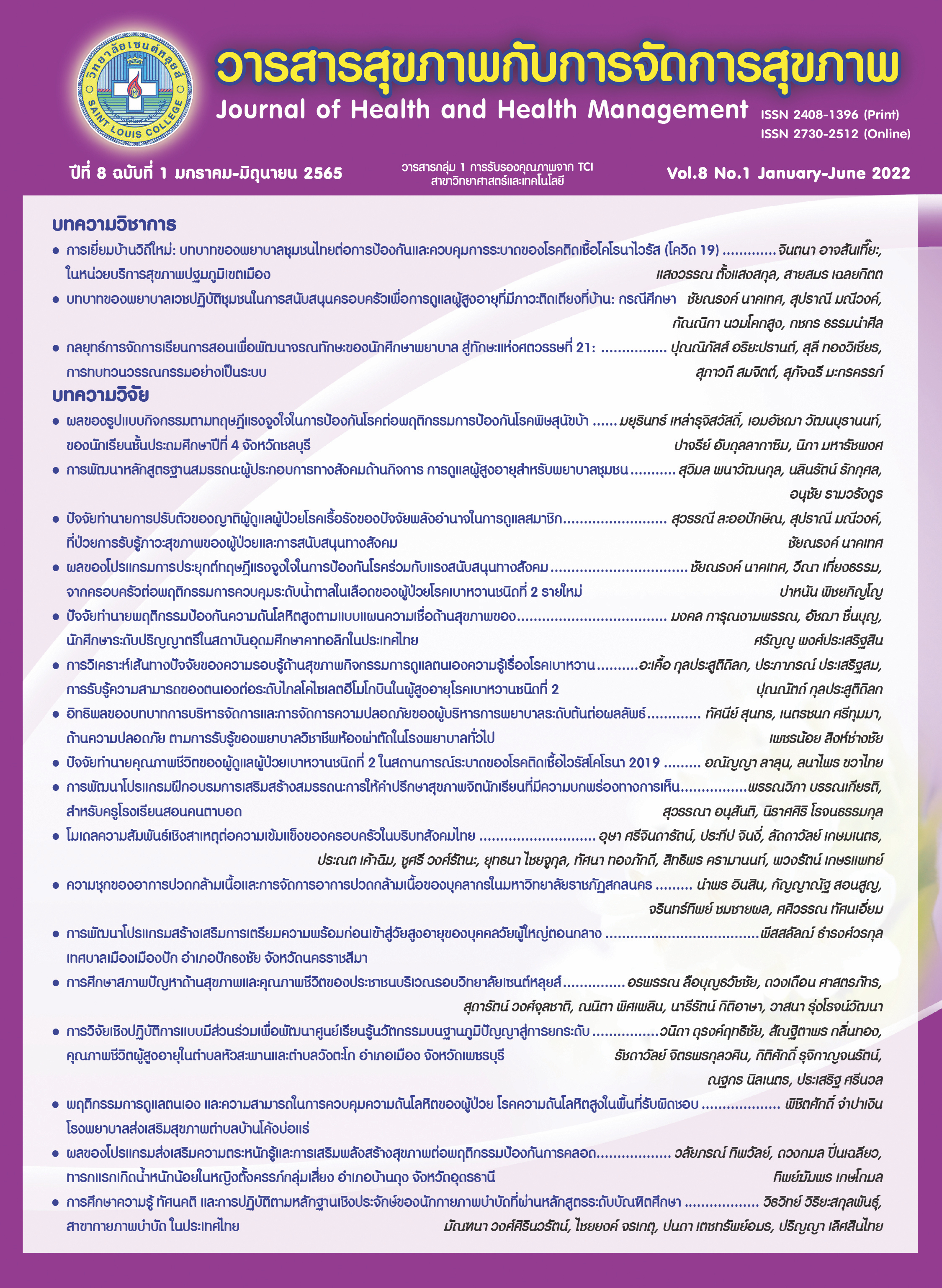Prevalence of Muscle Pain and Muscle Pain Management among Personnel of Rajabhat Sakon Nakhon University
Keywords:
Muscle pain, Personnel, Muscle pain managementAbstract
This survey research aimed 1) to study the prevalence of muscle pain among personnel of Sakon Nakhon Rajabhat University, 2) to compare the difference of the number of the muscle areas with pain between academic and support personnel, and 3) to explore how personnel manages muscle pain. The samples included 240 personnel, with 146 academic and 94 support staff selected by stratified random sampling. Data were collected by an online questionnaire comprised questions about perceived muscle pain in seven different areas including neck, shoulder, back, waist, arm, wrist, and eyes and the individual’s muscle pain management. The data were analyzed by descriptive statistics and Mann-Whitney U test. The results revealed that 90.0% of the samples perceived at least one specific area of muscle pain during the past three months (95%CI = 86.2 - 93.8). Meanwhile, 29.2% of them reported muscle pain in all specific areas. The support personnel had a significantly greater number of muscle pain areas than the academic personnel (p=0.004). In terms of muscle pain management, the samples frequently made changes to body posture, stretched muscles, and adjusted their sitting position.
References
ทรงฤทธิ์ ทองมีขวัญ และสกุนตลา แซ่เตียว. (2562).พฤติกรรมการป้องกันและการรับรู้ความเสี่ยงต่อการเกิดกลุ่มอาการคอมพิวเตอร์ซินโดรมของบุคลากรสายสนับสนุน. วารสารพยาบาลศาสตร์ มหาวิทยาลัยสยาม, 19(37), 69-83.
นรากร พลหาญ, สมสมร เรืองวรบูรณ์, โกมล บุญแก้ว, และอนุพงษ์ ศรีวิรัตน์. (2557). กลุ่มอาการที่เกิดต่อร่างกายจากการใช้คอมพิวเตอร์ในการปฏิบัติงานของ บุคลากรสายสนับสนุน มหาวิทยาลัยนครพนม. วารสารมหาวิทยาลัยศรีนครินทรวิโรฒ (สาขาวิทยาศาสตร์และเทคโนโลยี), 6(12), 26-38.
ปุญญพัฒน์ ไชยเมล์. (2556). การกำหนดขนาดตัวอย่างสำหรับการวิจัยเชิงพรรณนาในงานสาธารณสุข. วารสารมหาวิทยาลัยทักษิณ, 16(2), 9-18.
สุนันทา จำชาติ, ภาพร สาอ่อน, ปณิตา ศรีราวี, สุภัสรา วิชาพูล, และสิริทรพย์ สีหะวงษ์. (2564). ความชุกและปัจจัยที่มีความสัมพันธ์กับการปวดกล้ามเนื้อของบุคลากรที่ปฏิบัติงานในคณะพยาบาลศาสตร์มหาวิทยาลัยแห่งหนึ่ง. มฉก. วิชาการ, 25(1), 77-86.
ศูนย์วิทยาศาสตร์เพื่อการศึกษา. (2564). Work from Home อย่างไร ให้ไม่เป็นออฟฟิศซินโดรม. สืบค้นจาก https://sciplanet.org/content/8208
Chantaracherd, P. (2015). The office syndrome: a potential risk factor of TMD and headache. maybe vice versa?. Mahidol Dental Journal, 35(3), 265-272.
Chinedu, O. O., Henry, A. T., Nene, J. J., & Okwudili, J. D. (2020). Work-related musculoskeletal disorders among office workers in higher education institutions: A cross-sectional study. Ethiopian Journal of Health Sciences, 30(5), 715–724.
Ekpanyaskul, C., & Padungtod, C. (2021). Occupational health problems and lifestyle changes among novice working-from-home workers amid the COVID-19 pandemic. Safety and health at work, 12(3), 384-389.
Feng, B., Chen, K., Zhu, X., Ip, W. Y., Andersen, L. L., Page, P., & Wang, Y. (2021). Prevalence and risk factors of self-reported wrist and hand symptoms and clinically confirmed carpal tunnel syndrome among office workers in China: a cross-sectional study. BMC public health, 21(1), 1-10.
Kawai, K., Kawai, A. T., Wollan, P., & Yawn, B. P. (2017). Adverse impacts of chronic pain on health-related quality of life, work productivity, depression and anxiety in a community-based study. Family practice, 34(6), 656-661.
Meaza, H., Temesgen, M. H., Redae, G., Hailemariam, T. T., & Alamer, A. (2020). Prevalence of Musculoskeletal Pain Among Academic Staff of Mekelle University, Ethiopia. Clinical Medicine Insights: Arthritis and Musculoskeletal Disorders, 13, https://doi.org/10.1177/1179544120974671
Minoura, A., Ishimaru, T., Kokaze, A., & Tabuchi, T. (2021). Increased Work from Home and Low Back Pain among Japanese Desk Workers during the Coronavirus Disease 2019 Pandemic: A Cross-Sectional Study. International Journal of Environmental Research and Public Health, 18(23), https://doi.org/10.3390/ijerph182312363.
Ojoawo, A. O., Awotidebe, T. O., & Akindamola, G. A. (2016). Prevalence of work related musculoskeleal pain among academic and non academic staff of a Nigerian university. Gülhane Tip Dergisi, 58(4), 341-347.
Schmidt, K. G., Holtermann, A., Jørgensen, M. B., Svendsen, M. J., & Rasmussen, C. D. N. (2021). Developing a practice and evidence-based guideline for occupational health and safety professionals to prevent and handle musculoskeletal pain in workplaces. Applied Ergonomics, 97,(11), https://doi.org/10.1016/j.apergo.2021.103520.
Van Eerd, D., Munhall, C., Irvin, E., Rempel, D., Brewer, S., Van Der Beek, A. J., ... & Amick, B. (2016). Effectiveness of workplace interventions in the prevention of upper extremity musculoskeletal disorders and symptoms: an update of the evidence. Occupational and environmental medicine, 73(1), 62-70.
Walsh, T. P., Arnold, J. B., Evans, A. M., Yaxley, A., Damarell, R. A., & Shanahan, E. M. (2018). The association between body fat and musculoskeletal pain: a systematic review and meta-analysis. BMC musculoskeletal disorders, 19(1), 1-13.
Downloads
Published
How to Cite
Issue
Section
License
Copyright (c) 2022 Journal of health and health management

This work is licensed under a Creative Commons Attribution-NonCommercial-NoDerivatives 4.0 International License.




